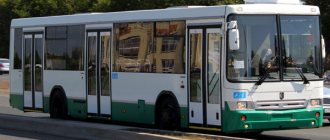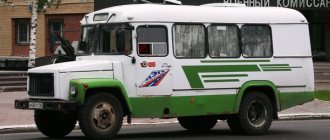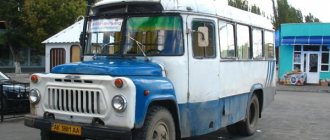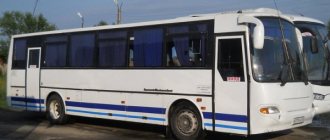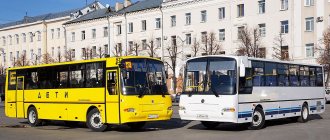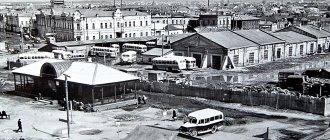KAvZ 3270 is a bus produced by the Kurgan Bus Plant of the Soviet Union in the late 80s, a vehicle with a rich history and original design. In 1986, inspired by the successful testing of the KAvZ 685M bus, which was produced in 1984-1986 on the new, experimental GAZ 53-12 1040 chassis, the engineers of the Kurgan plant decided to continue converting the bonnet buses of the 685 series. However, as often happens in our country, the reconstruction turned out to be so large-scale that the result was a completely different bus - KAvZ 3270.
Coincidentally, at the same time, a document regulating the new procedure for indexing passenger transport (cars, buses and trolleybuses) came into force. This document was the “Industry Standard” of 1966, No. 025270-66, according to which all passenger transport was divided into 6 classes by size. Hence the number 3 at the beginning of the index 3270, which means “small class, 6-7.5 meters” and the number 2, which shows that we are talking about a bus. The last two digits indicated the serial registration number of the model.
What's new in the technical characteristics of the KAvZ 3270 compared to the 685 model? Let's get a look.
KAvZ-3271 Wikipedia
| KAvZ-685 | |
| KAvZ-3270 | |
| Manufacturing plant | / KAvZ |
| Produced, years | KAvZ-685: 1971—1984 KAvZ-685M: 1984—1986 KAvZ-3270: 1986—1991 KAvZ-3271: 1991—1993 |
| Gross weight, t | 4,08 |
| Max. speed, km/h | 90 |
| Bus class | average |
| Capacity | |
| Nominal capacity (5 people/m²) | 21 |
| Full capacity (8 people/m²) | 28 |
| Dimensions | |
| Front wheel track, mm | 1 630 |
| Rear wheel track, mm | 1 970 |
| Length, mm | 6 500 |
| Width, mm | 2 550 |
| Roof height, mm | 3 030 |
| Base, mm | 3 700 |
| Salon | |
| Number of doors for passengers | 1 |
| Engine | |
| Engine model | ZMZ-53A, ZMZ-513.10 |
| Fuel type | petrol |
| Fuel consumption at 60 km/h, l/100 km | 24 |
| Transmission | |
| Gearbox type | mechanical |
| Number of gears | 4 |
| KAvZ-685 on Wikimedia Commons | |
KAvZ-685
- Soviet middle-class bus with a bonnet design on a GAZ-53-12 truck chassis.
Story
At the end of the 60s, the first prototypes of the bus appeared. Since 1971, KAvZ-685 began to be produced in pilot production batches. These vehicles differed from future production vehicles in having four-piece composite windshields, which were replaced on production buses with two curved windows. Serial production of the bus began in 1973.
In 1975, instead of round taillights and brake lights, new, rectangular ones were used. The front direction indicators were also changed - they became two-color.
At the end of 1977, the bus was awarded the “Quality Mark”.
Later, various modifications of the bus were produced, which were produced until 1989.
Technical description
The KAvZ-685 was a low-capacity bonnet bus, like its predecessor KAvZ-651B, and was intended primarily for work in rural areas. The KAvZ-685 differed from its predecessor in the increased overall dimensions of the cabin, a more modern design, had improved traction and dynamic performance, increased reliability and increased overhaul intervals.
The chassis of the new bus was a special modification of the basic GAZ-53A chassis - GAZ-53-40. It had a reinforced frame and suspension, a V-shaped carburetor eight-cylinder engine. To transmit the increased torque, a reinforced single-disc clutch, a new gearbox and a new driveshaft were used. Since 1975, the braking system has received a dual-circuit hydraulic drive with two hydraulic vacuum boosters and a brake warning light.
KAvZ-685 had a warm passenger compartment, comfortable soft seats with small handrails of the original design, a driver's seat partially separated from passengers, good ventilation with sliding side windows and upper hatches in the roof, and good lighting. The KAvZ-685's overhaul mileage averaged 260 thousand km.
Modifications
- KAvZ-685S - was designed for operation in the northern regions of the country at temperatures down to −60°C.
- KAvZ-685G - intended for work in the mountains at an altitude of 3-4 thousand meters.
- KAvZ-685M (1984-1986) - a modernized version of the bus. It was produced on the Gorky GAZ-53-12 chassis and with the new ZMZ-53-11 engine.
- KAvZ-3270 (1986-1991) - a modernized version of KAvZ-685M with industry indexing in accordance with GOST.
- KAvZ-3271 (1991-1993) - transitional to KAvZ-3976.
Links
Literature
- Lapshin F.
Farewell to the “Kavzik” // Autoreview. - 2008. - No. 15 (408). - Markov N., Dementyev D.
“Boxes” of all Russia // Commercial transport. - 2008. - No. 5, 6, 7.
wikiredia.ru
Modifications
Over twenty years, a large number of different modifications have been released.
KAvZ 685S - this model is adapted for work in northern latitudes. Moreover, the machine can be used even at -60 degrees. The interior of the car is lined with insulation from the inside, additional double-glazed windows and backup heating devices have been installed.
KavZ 685G is a mountain version of the model. On the car you can find more powerful brakes equipped with an electrodynamic element. Seat belts are attached to each seat
KAvZ 685M is a modernized model, it has an improved power plant.
ZMZ-53-11 (16 hp), maximum speed up to 85 kilometers per hour.
KAvZ 3270 is a more modern version of the famous bus. The car was produced in compliance with new requirements and environmental standards.
KAvZ-3271 – Kyiv buses
| The KavZ bus was built at the Kurgan Bus Plant on the basis of the GAZ-53 car and is very reminiscent of the first post-war buses. This strange name of the model - “KAvZ” - is explained simply: “[K]urgan [Bus] Plant.” The letter “v” is used in the name of the model due to the fact that the abbreviation KAZ was taken by the Kutaisi Automobile Plant (which produced the famous Kolkhida truck tractors). And for the Kurgan plant, at the prototype stage, the abbreviation KuAZ was used, but in the end they settled on the current one. In total, throughout its history, the Kurgan Bus Plant produced the following models: “KAvZ-651” - an ancient bus with small roll-up windows (like in old trams) and the front part of the body from the GAZ-51A (with protruding wings). In the 1970s, production of the KavZ-685 began. It differed in a slightly modified body (the windows were already sliding) and, most importantly, in the front end from the GAZ-53 truck. Most of the existing vehicles are KAVZ-685. Since 1987, the KaVZ-3270 model began production - a slightly improved version of the KaVZ-685. Externally, models “3270” can be distinguished from “685” by the windshield: the wipers on the “3270” have moved to the upper part of the windshield. In 1992, production of the KAVZ-3976 model began, the main difference of which is the presence of a modern front end, like the GAZ-3307 truck. Since 1989, the Gorky Automobile Plant began serial production of the GAZ-3307 truck, designed to replace the outdated GAZ-53 model. At the same time, in Kurgan they began preparing for the production of a new model of a hooded bus on a new chassis. The transition model was the KAvZ-3271, which was produced in 1991-1993. This bus was still created on the GAZ-53-12 chassis, but received a new steering column and dashboard, which were later used on the new KAVZ-3976 model. Serial production of the latter began in 1992, but, nevertheless, the assembly of KAvZ-3271 continued in parallel until the beginning of 1993. In Kyiv, such cars were not used until 2001, when several copies appeared specifically for work on route 93, on which recently the large Ikarus-260 and LAZ-52523 carried very few passengers. These vehicles were transferred from the Kievelektrotrans auto-mechanical base, where they had previously worked as service vehicles. The cabin has 21 seats and 9 standing ones. The door to the cabin is opened manually by the driver, just like 30 years ago. The design of the bus leaves much to be desired, since it was designed back in the 60s. 2 buses of this model could be found on route 93 around 2002-2003. Later, the buses operated on routes No. 67, 118, impressing the public with their appearance. The machines worked until about 2007, when they went into oblivion. © Kievbus, 2003-2012. Last update - 05/05/2003/01/07/2012 | 3605 160-14 KA Bus "KAvZ-3270" route 93 near the control room "Petrovka". The route passes through Petrovka in transit, but at the beginning and end of the working day you need to make a note at the control room. 3605 160-14 KA Side view. This “rural” bus looks a little wild in Kyiv. 3605 160-14 KA It is clearly noticeable that the seats in the back of the bus are not located flush against the rear wall. 3605 160-14 KA The bus follows route 93 on Krasnykh Kazakov Avenue. In the background is a green Ikarus-250. In a year the route will be closed... 3606 160-15 KA The second bus KAvZ-3271. 3606 160-15 KA Car interior. View from the front door to the back. 3606 160-15 KA Salon. There are not enough seats for a city bus, and the small distance between the seats - all this makes the car convenient for local traffic in rural areas. 3606 160-15 KA Salon. View from the rear seats. On the left, one of the seats is turned to the opposite direction of movement. The photo also shows a handrail, the only one in the entire salon. |
www.kievbus.info
External differences
The most obvious changes affected the design of the bus. The front roof slope has received a new design. If you look at the 685 or 685M, the front of the bus has a router visor above the windshield. Model 3270 does not have this visor. The rear-view mirrors, which were located on the outside sides of the KAVZ 3270 bus, received new brackets. A second ventilation hatch appeared on the roof, and a little later in 1989, the windshield wipers became electric with a modified design of the blade arms. They also “moved” from the bottom of the windshield to the top and began to be located on each side of the router.
Serial production of the KAvZ 3270 did not last long, only a little over 3 years. The suburban Kurgan bus was in wide demand by various urban and rural enterprises, state and collective farms as official vehicles and was in use for at least another 5-7 years after the official discontinuation of production. It is not known for certain how much this bus cost at that time, but today the price of a KavZ 3270 with low mileage costs from 90,000 rubles to 130,000 rubles.
At the beginning of 1989, at the request of the USSR Government, all buses had to undergo mandatory certification according to the new GOST No. 278512-88. The plant's designers had 2 years to refine the current buses in accordance with the new rules, which led to the cessation of production of the 3270 bus and the start of production of special KAVZ 3271 buses. In essence, this was the same 3270, but with a new steering and dashboard. The era of the “bonnet” 685/3270/3271 finally ended in 1991, when the Gorky Automobile Plant stopped serial production of the GAZ 53-12 chassis.
KAvZ 3270: price, technical specifications, photos, reviews, KAvZ 3270 dealers
Technical characteristics of KAvZ 3270
| Year of issue | 1986 |
| Body type | Bus |
| Length, mm | 6500 |
| Width, mm | 2550 |
| Height, mm | 3030 |
| Number of doors | 3 |
| Number of seats | 21 |
| Trunk volume, l | — |
| Country of assembly | USSR |
Modifications of KAvZ 3270
KAvZ 3270 4.2 MT
| Maximum speed, km/h | 90 |
| Acceleration time to 100 km/h, sec | — |
| Engine | Petrol |
| Working volume, cm3 | 4250 |
| Power, hp / rpm | 120/3200 |
| Torque, N m / rpm | 291/2000-2500 |
| Consumption on the highway, l per 100 km | — |
| Consumption in the city, l per 100 km | — |
| Combi consumption, l per 100 km | 19.0 |
| Gearbox type | Mechanical, 4 gears |
| Drive unit | Rear |
| Show all characteristics | |
Odnoklassniki KAvZ 3270 price
Unfortunately, this model is unique in its price range or is no longer available.
Reviews from KAvZ 3270 owners
KAvZ 3270, 1986
The bus is a legend. Engine ZMZ 511.10, carburetor, 8 cylinders. 4-speed gearbox. A very warm interior thanks to the powerful auxiliary heater. Soft seats and sliding side windows save you from the heat in summer. There are hatches. The chassis on the KAvZ 3270 is, of course, not the most comfortable. But it is reliable and strong. At the rear, springs from GAZ 66 and two telescopic shock absorbers were used. The bus is not afraid of any loads. The mileage between repairs is 260 thousand km. There have been cases where these buses lasted up to 300 thousand without major repairs. Control fuel consumption at a speed of 60 km per hour is about 20 liters. It's a shame they don't make them anymore. Despite the outdated archaic design, KAVZ 3270 buses are highly reliable, and they can be repaired yourself.
Advantages
: classic. Warm interior. Endurance. Patency.
Flaws
: Outdated design.
Konstantin, Bryansk
Official KAvZ dealers
Select the official KAvZ dealer closest to you on the map.
×
To view the dealer’s contact numbers, opening hours, photos of the car dealership, reviews about it and directions, click the “Enlarge map” link.
Video KAvZ 3270 - test drives
KAvZ 3270 / KAvZ 3270
The medium-sized KAVZ 3270 buses appeared in 1986 as a result of the modernization of the previous model 685M. Externally, the KAvZ 3270 was actually the same as the 685M. The main changes occurred in the chassis and engine. In particular, the bus's load capacity has been increased by 0.5 tons, and the power unit has received a power increase of 5 hp. In addition, the brake system has undergone changes, which has acquired a 2-circuit design, a hydraulic drive and a vacuum booster. The modernization of the 4-speed transmission has resulted in improved dynamic qualities, while the maximum speed has increased, which is now 90 km/h. The bus frame was significantly strengthened, the semi-elliptical suspension was equipped with additional springs and telescopic shock absorbers, due to which the ride harshness was noticeably reduced.
KAvZ 3270 received a spacious interior with 21 seats. In winter, it was always warm inside the bus - a comfortable temperature was provided by an additional radiator from Moskvich. For convenience, the soft seats were equipped with handrails, and thanks to the sliding window design and 2 upper hatches in the roof, passengers received good air ventilation in the summer. Serial production of the KAvZ 3270 lasted only 3 full years - at the beginning of 1989, the USSR Government demanded that the model be adjusted to the new GOST framework. As a result, modification 3271 comes off the assembly line with modernized controls and instrument panel. In 1989, the era of hooded KAVZ buses with a cargo chassis from the GAZ 53 ended when the Gorky plant stopped producing outdated GAZons, replacing them with a new model designated 3307.
avto-russia.ru
Another legend - Community "Trucks and Buses" on DRIVE2
KAVZ 685\3270\3271
At the end of the 60s, the first prototypes of the bus appeared, which received the designation KAvZ-685. The design of the front end of the experimental vehicles included a different radiator lining than the base GAZ-53A chassis with a four-headlight lighting system, which was later abandoned on production vehicles - their front end was similar in design to the base chassis. To master the serial production of buses, it was necessary to reconstruct the entire enterprise and expand the production area. The general reconstruction of KavZ began in 1968. Since 1971, KAvZ-685 began to be produced in pilot production batches. These vehicles already had a standard hood lining, but differed from future production vehicles in having four-piece composite windshields, which were replaced on production buses with two curved windows. Serial production of the bus began in 1973, when the first stage of reconstruction of the enterprise was completed, and in 1974 the 100,000th bus (since the start of production in 1958) rolled off the assembly line.
In 1975, changes occurred in the bus lighting technology. Instead of round taillights and brake lights, new, rectangular ones were used. At the same time, KAvZ became one of the first domestic factories to use new-style lighting technology on its models. The front direction indicators were also changed - they became two-color. At the end of 1977, the bus was awarded the “Quality Mark”. A plastic pentagon proudly adorned the radiator lining of the bus between the right headlight and the sidelight. The 200,000th KAVZ bus rolled off the main assembly line in 1982, on the day of the plant’s 24th anniversary. The general design principle did not change compared to the previous 651 model - it was still the same low-capacity hooded bus, extremely easy to maintain and intended primarily for work in rural areas. In addition to significant differences in the chassis design, the KAVZ-685 differed favorably from the previous Kurgan bus in its increased overall interior dimensions and more modern design. The bus was designed for 28 passengers, had improved traction and dynamic performance, increased reliability and increased overhaul intervals.
The chassis of the new bus was a special modification of the basic GAZ-53A chassis - GAZ-53-40. It had a reinforced frame and suspension, a V-shaped carburetor eight-cylinder engine. To transmit the increased torque, a reinforced single-disc clutch, a new gearbox and a new driveshaft were used. Since 1975, the braking system received a dual-circuit hydraulic drive with two hydraulic vacuum boosters and a brake warning light, which significantly increased the safety of the bus. Interestingly, these changes were introduced on the basic Gorky chassis only in 1986. The steering did not have a hydraulic booster. The bus chassis differed from the chassis of the GAZ-53A truck by a softer rear suspension with springs from the GAZ-66 and two telescopic shock absorbers, a modified power system with a fuel tank from the GAZ-66, and electrical equipment with an alternator. KAvZ-685 had a very warm passenger compartment (thanks to the presence of a powerful additional heater, which used the radiator of the Moskvich car), comfortable soft seats with small handrails of the original design, a driver's seat partially separated from passengers, good ventilation with sliding side windows and top hatches in the roof, good lighting. The KAvZ-685's overhaul mileage was 260 thousand km, but many vehicles traveled for 300 thousand km or more before major repairs.
Since 1984, production of KAVZ-685M buses began on the modernized Gorky GAZ-53-12 chassis. The new chassis differed from the previous one with the ZMZ-53-11 engine. Engine power was 120 hp, fuel consumption decreased by 5-7%. The chassis design has strengthened the frame elements, front axle beams and springs. Externally, the new bus differed from the KAvZ-685 only in the modified radiator lining, which was characteristic of the base chassis. The next modernization of Kurgan buses took place in 1986. At the same time, the bus was assigned a new four-digit index 3270 in accordance with the industry standard OH 025270-66, adopted back in 1966. The KAvZ-3270 was distinguished by the shape of the front roof slope above the windshield - the visor was replaced by a new route indicator without a visor. Since 1989, the Gorky Automobile Plant began serial production of the GAZ-3307 truck, designed to replace the outdated GAZ-53 model. At the same time, in Kurgan they began preparing for the production of a new model of a hooded bus on a new chassis. The transition model was the KAvZ-3271, which was produced in 1991-1993. This bus was still created on the GAZ-53-12 chassis, but received a new steering column and dashboard, which were later used on the new KAVZ-3976 model. Serial production of the latter began in 1992, but, nevertheless, the assembly of KAvZ-3271 continued in parallel until the beginning of 1993. Along with the base model, a gas-cylinder modification was also produced on a special GAZ-53-19-040 chassis. This bus could run on both gasoline and liquefied gas, for which it was equipped with gas equipment and a gas cylinder with a capacity of 170 liters. More: trucks.autoreview.ru/archive/2008/07/kavz/ Modifications of KAvZ-685: KAvZ-685S - was designed for operation in the northern regions of the country at temperatures down to -60°C. It differed from the base model in its insulated body with double glazing and a driver’s workplace separated from the passenger compartment. To heat the passenger compartment, two independent heaters were used, which were mounted under the floor of the body in special compartments. In addition, an additional fuel tank with a capacity of 56 liters was installed in the rear overhang on the left. All rubber products and tires were manufactured in a special northern design. KAvZ-685M, KAvZ-3270, KAvZ-3271 - also produced in “northern” and “mountain” versions. KAVZ-685G - was designed to work in the mountains at an altitude of 3-4 thousand m. It had a cooling system with an expansion tank and an auxiliary brake system with an electrodynamic retarder acting on the transmission. An additional parking brake, a “mountain stop,” was mounted behind the rear wheels. The bus seats were equipped with seat belts.
КАвЗ-685, 685М, КАвЗ-3270, КАвЗ-3271 Годы выпуска 1971-1984, 1984-1986, 1986-1991, 1991-1993 Габариты (Д/Ш/В), мм 6500 х 2550 х 3030 Колёсная база, мм 3700 Disp. and number of cylinders V8 Power system carburetor Engine displacement, l 4.25 (ZMZ-53A, ZMZ-53-11) Equipment weight. \ full, kg 4030-4080 \ 6289-6780 Engine power, l. With. at rpm 115\3200, 120\3200 Torque, Nm 284.5 Steering gear globoidal worm with three-ridge roller Number of seats / total 21 (total 28+2) Gearbox 4-speed. fur. (GAZ-53-12) Wheel formula, drive type 4x2, rear Suspension front/rear dependent, on semi-elliptic springs with shock absorbers \ -||- with additional springs Dual-circuit brake system, with hydraulic drive (since 1975) and vacuum amplifier, drum-type mechanisms Maximum speed, km/h 80, 90 Acceleration time to 60 km/h, s 33.6 Fuel consumption at 60 km/h, l/100 km 24, 18.3-19 (A-76)
www.drive2.ru
For those who carry
From the driver’s point of view, the Aurora does not amaze with its discoveries, but conscientiously performs the functions assigned to it. A trio of classic analog instruments provides information on all important parameters. The panel contains quite compact “tables” of keys. In general, a working interior without frills. I would especially like to note that the Aurora family became the first vehicle equipped with a new universal steering wheel, which had previously been occasionally found on PAZ buses and KAMAZ trucks.
The iron component of the bus consists mostly of well-known brands. Gearbox – ZF, injection pump and injectors – Bosch, control unit – Continental, air blower – Holset, clutch – Sachs, muffler and converter – Cummins, compressor – Knorr-Bremse. Domestic manufacturers received the KAAZ rear axle, MAZ steering gear, RAAZ brake chambers and LAAZ air filter among the significant elements.
The row of seats opposite the 2nd door is equipped with three-point belts
Deep shelving with wide intershelf distances
1 / 2
But replacing the headlamp units with Hella spot optics was not a success. More precisely, the plant is ready to supply such headlights to order, but customers are not yet happy with the price of modernization - it’s expensive. It would be possible to install an inexpensive analogue, so to speak, for both ours and yours, but the factory workers, after experimenting, concluded that the optics becoming cloudy after six months was a blow to the image of the plant, and they refused.
The layout of the main and other working bodies does not raise any special questions. There is nothing hanging under the bottom, hoses and wires are not dangling, and there are no complex manipulations to carry out shift maintenance. In addition to the shortcomings indicated in the photo, I will note the strange fastening of some equipment in the side compartments - either with self-tapping screws or stepladders through the floor. After six months, you won’t be able to unscrew them - you can only cut them off.
Separate monitor above the panel - GLONASS system
The interior mirror is equipped with a video camera
Pedal on the floor - mountain brake
But the idea with a flexible muffler corrugation seemed interesting - there is no need to fence complexly curved pipes. And the exhaust pipe of the autonomous heater, placed to the side, will allow you not to worry about the hole being clogged with sticky porridge from under the wheels in winter and, as a result, this useful element failing.
In principle, the proven design allows the plant to provide a guarantee for the bus for 100 thousand km or 12 months.
KAvZ 3270 4.2 MT: price, technical characteristics of KAvZ 3270 4.2 MT
| Model year | 1986 |
| Body type | Bus |
| Length, mm | 6500 |
| Width, mm | 2550 |
| Height, mm | 3030 |
| Ground clearance, mm | 265 |
| Front track, mm | 1630 |
| Rear track, mm | 1970 |
| Wheelbase, mm | 3700 |
| Curb weight, kg | 4080 |
| Total weight, kg | 6780 |
| Trunk volume, l | — |
| Number of doors | 3 |
| Number of seats | 21 |
| Drive unit | Rear |
| engine's type | Petrol |
| Number of cylinders / arrangement | 8/V-shaped |
| Engine power, hp/rpm | 120/3200 |
| Engine displacement, cm³ | 4250 |
| Torque, N m / rpm | 291/2000-2500 |
| Type of fuel | A-76 |
| Fuel tank volume, l | 105 |
| Acceleration time to 100 km/h, sec | — |
| Maximum speed, km/h | 90 |
| Fuel consumption in the urban cycle, l per 100 km | — |
| Fuel consumption on the highway, l per 100 km | — |
| Fuel consumption in the combined cycle, l per 100 km | 19.0 |
| Gearbox type | Mechanical, 4 gears |
| Power steering | Power steering |
| Front suspension | Dependent, spring |
| Rear suspension | Dependent, spring |
| Front brakes | Drums |
| Rear brakes | Drums |
| Climate control | No |
| Tire size | 8,25-20 |
avto-russia.ru
Advantages
It was assumed that the bus would be used in areas with a lot of unpaved surfaces. Because of this reason, additional details were initially included in the designed model for a high level of cross-country ability. As for the chassis, it was made with an excessive margin of safety.
For its time, the 685 was an advanced machine that had good technical characteristics and was on par with the best examples:
- Four-stroke carburetor power plant (3M3-53A).
- V-shaped layout
- Eight-cylinder engine capable of developing 122 hp.
- RPM 3220.
- Engine capacity is 4255 cubic centimeters.
Fuel consumption is approximately 24 liters per 100 kilometers. Moreover, the car could move at speeds of up to 90 kilometers per hour. The gearbox was a four-speed manual. The tank held about 110 liters of fuel. Essentially, the bus was an improved GAZ model with serial number 53-12. This model had synchronizers for 3rd and 4th gear.
The clutch had a single disc and was engaged using a hydraulic drive. The brake system had two circuits. There were also drum elements that connected both wheels.
There was also one in which there was an effective vacuum amplifier. The most versatile tires were installed, tread 8.20 R20.

